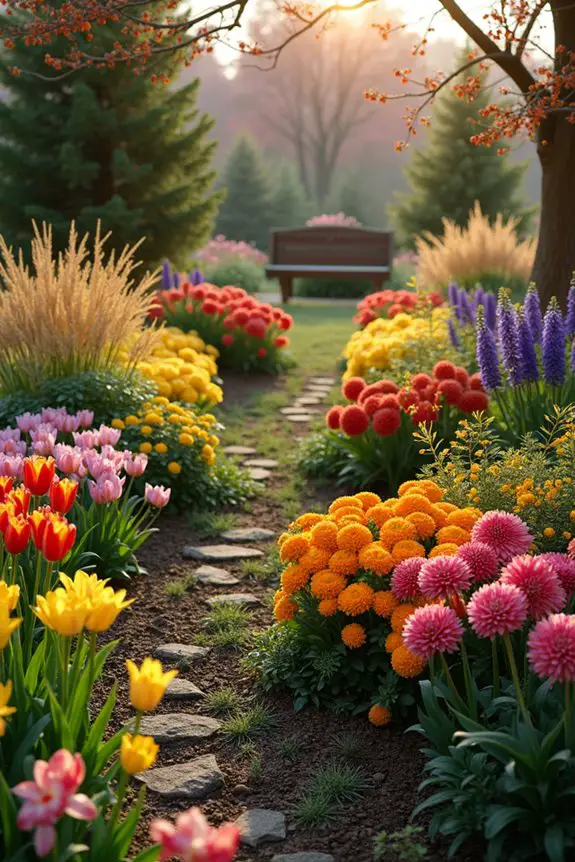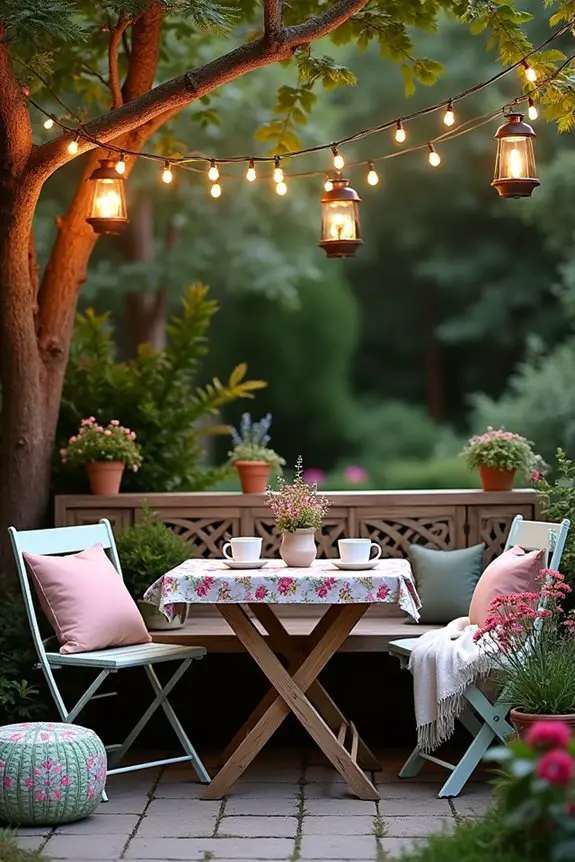Your outdoor space is like a blank canvas just waiting for your personal touch. Imagine giving it a fresh coat of inspiration, transforming it into a serene oasis. So, are you ready to immerse yourself in some creative garden design ideas? Let’s explore how you can layer textures, choose the right colors, and create cozy nooks that beckon you outside. Trust me, your garden will thank you for it, even if it’s just a little patch of green.
Creative Layout Concepts
When creating your garden layout, think about how color can set the mood—after all, you wouldn’t want to mix bright yellows with dull browns, right?
Consider including some Zen garden elements for that calming vibe, and don’t forget about pairing plants that get along like peanut butter and jelly.
You could even carve out a cozy outdoor living space, using sustainable materials that make your garden not just pretty, but eco-friendly too.
1. Color Palette Selection
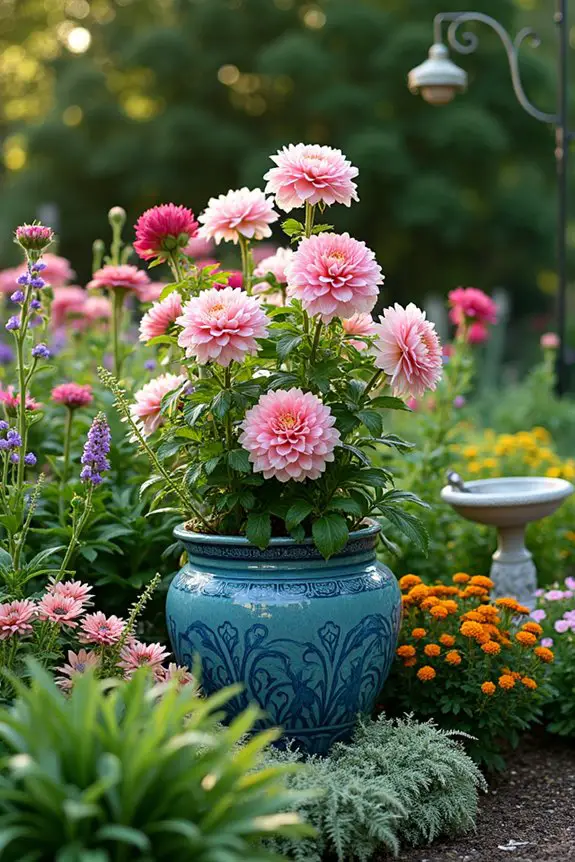
When it comes to designing your garden, choosing the right color palette can be a game-changer. Not only does it influence how your space feels, but it also ties everything together beautifully. Imagine stepping into a vibrant oasis or a serene retreat—sounds dreamy, right?
Let’s explore some creative layout concepts to help you pick that perfect color scheme.
First, start by selecting a primary color that speaks to you. This could be anything from a calming blue to an energizing yellow. Once you have your main hue, think about complementing it with two or three additional colors. A good rule of thumb is to use the 60-30-10 rule: 60% of your space should feature your primary color, 30% should be your secondary colors, and the remaining 10% can be an accent or a pop that gives your garden a little something extra—like that finishing sprinkle of sea salt on a delicious dish.
Next up, let’s talk plants. Consider seasonal blooms that reflect your chosen palette. For a soft pastel theme, think peonies, lavender, and white hydrangeas. For bolder vibes, deep red dahlias and bright orange marigolds might strike your fancy.
Remember, plants aren’t just functional; they’re also artists in your garden, adding flair and creating layers of color and texture. Additionally, using T8 fluorescent grow lights can help support the growth of your plants, ensuring a thriving garden even in less than ideal light conditions.
Now, while that sounds great in theory, I once planted an entirely pink garden—think cotton candy meets flamingo show—and let’s just say, my neighbors were a tad confused. But hey, if you go for something bold, embrace it with confidence. Don’t be afraid to deviate from the norm; this is your space, after all.
As for the layout, think about how to arrange your flowers and foliage. Consider grouping plants in clusters—an arrangement where your primary color pops, then softly fades into secondary hues. This creates a gradient-like effect that draws the eye in and creates a rhythm throughout your garden.
And don’t forget about height; place taller plants at the back or center of beds, and let shorter flowers or foliage frame the edges.
Finally, use garden decor like pots, sculptures, or even lighting to tie in your color scheme. A vibrant blue pot holding rich green ferns can add a splash of style, creating an eye-catching focal point.
So next time you’re debating which plant goes where or what color to use, take a step back and visualize the harmonious vibe you want to create. With a little planning and creativity, your garden can become a breathtaking kaleidoscope of colors, all while reflecting your unique style.
Happy gardening.
2. Zen Garden Elements
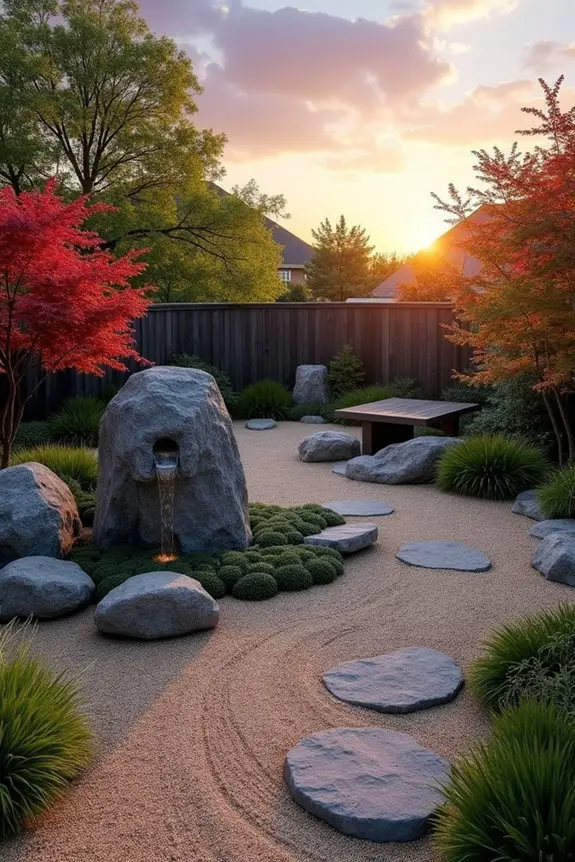
Creating a Zen garden is a fantastic way to cultivate tranquility in your outdoor space. It’s not just about raked sand and carefully placed rocks—it’s an artful blend of simplicity and nature that brings a sense of peace to your gardening experience. And let’s be honest, who wouldn’t want a calming retreat right outside their door?
So, if you’re looking to immerse yourself in this serene world, let’s explore some key elements that will help you design the perfect Zen garden.
First and foremost, think about the layout. A Zen garden typically includes three main elements: rocks, sand or gravel, and plants. Start by selecting a natural stone or boulder as a focal point. This could be a larger rock that anchors the space or a cluster of smaller stones arranged in a pleasing pattern.
The placement is important—place rocks in odd numbers to create visual interest. You want to create a harmonious balance that feels inviting yet subtly structured, like a cozy corner in a busy café.
Next comes the sand or gravel. This layer symbolizes water and can be raked into beautiful patterns, mimicking waves or ripples. Grab a sturdy rake and let your creativity flow—just don’t get too carried away; it’s not a full-on sandcastle competition. Using long handled pruning loppers can make maintaining the surrounding plants effortless and help keep the space tidy.
Aim for a consistent texture and color that complements your rocks. I made the mistake of using sparkly white gravel once—it was a spectacle, but the vibe was more disco than Zen. So, opt for something earthy and calming like fine quartz or natural pebbles.
Plants are your final touch, but keep it minimal. Select a few low-maintenance varieties, like Japanese maple or ornamental grasses, as a nod to traditional Japanese gardens. Position these alongside your stones, creating pockets of greenery that break the stone and sand contrast.
Remember, the goal here is serenity, so avoid planting too many distractions—no jungle vibes allowed. I learned that the hard way; my first Zen garden ended up resembling a botanical wild kingdom rather than a peaceful retreat.
Lastly, think about additional features like a water element—perhaps a small fountain or a reflecting pool. The sound of trickling water can enhance the calming environment you’re aiming for. Additionally, incorporating garden gate hinge kits can ensure that any gates used in your design open and close smoothly, maintaining the peaceful ambiance of your garden.
If you have the space, a simple bamboo fountain can add a touch of tranquility, and it looks pretty cool as a bonus. And as for seating? A simple wooden bench or a few stones to sit on offers the perfect spot to enjoy your beautiful creation and sip some tea.
3. Symbiotic Plant Pairings
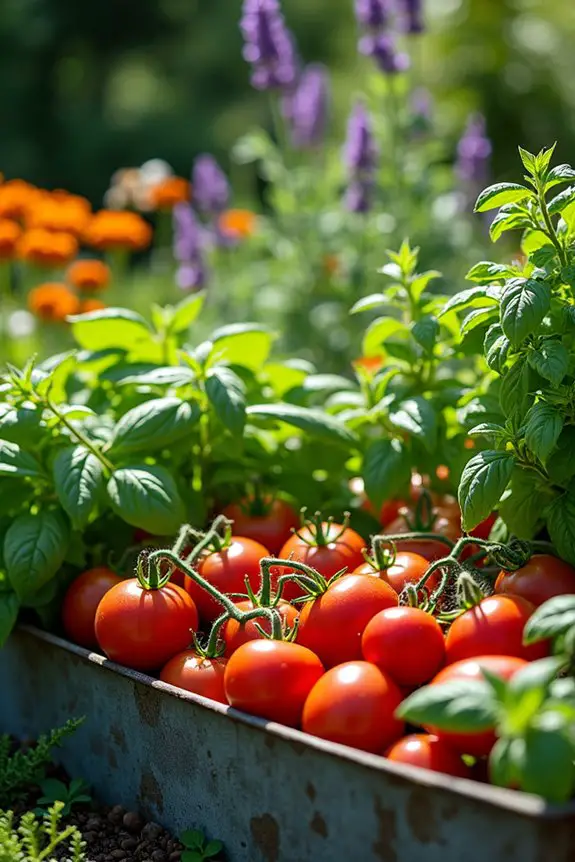
When it comes to creating a beautiful garden, pairing plants together isn’t just about picking your favorites; it’s about finding the perfect match that enhances each other’s growth and beauty. Think of it like a buddy system; certain plants thrive alongside one another, offering both functional benefits—like pest control or nutrient sharing—and a stunning visual appeal that brings harmony to your space.
Plus, who doesn’t want a garden that looks good and is easy to maintain?
So, let’s explore the world of symbiotic plant pairings. One combo that works like a charm is planting tomatoes with basil. Not only does basil help keep pesky bugs away from your tomatoes, but it also brings a burst of flavor to your summer salads. For the best results, plant your basil about 12 inches away from your tomatoes—enough to give them some breathing room but close enough that you can snag some fresh leaves whenever you need them.
And honestly, nothing beats that smell. You’ll feel like a master chef every time you walk out to grab dinner.
Now, if you’re looking for some foliage flair, consider pairing ferns with hostas. These two thrive together with their love for shade and moist soil. Arrange them in a cozy corner of your garden where they can form a lush, green carpet.
Make sure to plant the ferns on the outer edges and group the hostas in the center. This layout creates a layered look that’s visually appealing; you’ll feel like you’ve stepped into a secret forest hideaway.
Pro tip: use a few different varieties of hostas for an added dimension—they come in various colors and sizes. Just make sure to keep the plants spaced out to avoid an overgrown jungle vibe.
Trust me, no one wants to be lost in a hosta labyrinth.
Another delightful duo is marigolds and nasturtiums. Marigolds are fantastic for repelling aphids, while nasturtiums add a pop of color and even provide edible flowers for salads. When planting these beauties, scatter them around your vegetable garden to create a vibrant border.
A word of caution: nasturtiums like to spread, so either give them enough room to roam or be prepared for an occasional pruning session. You’ll thank yourself when you’re enjoying fresh veggies without the insect drama.
And let’s not forget the delightful dance between lavender and rosemary, perfect for a sunny spot. Both love well-draining soil and repel pests, so they make great companions in herb gardens.
Plant them together, and you’ll create an aromatic haven that could soothe even the most frazzled of souls. Space them about 18 inches apart to allow them room to grow, and remember to give your lavender a trim for a neat look.
Who wouldn’t want to inhale the sweet scent of herbs each time they step outside? How very Pinterest-perfect.
In short, choosing the right plant pairings is like inviting friends over for a dinner party. You want the right mix to create a harmonious atmosphere filled with beauty and functionality.
Consider using galvanized raised beds to provide a stunning structure for your plant combinations.
So go ahead, experiment with these combinations, and watch as your garden flourishes and blooms into something truly magical. You might even feel a little like a gardening wizard, enchanting your surroundings with each thoughtful choice.
4. Outdoor Living Spaces
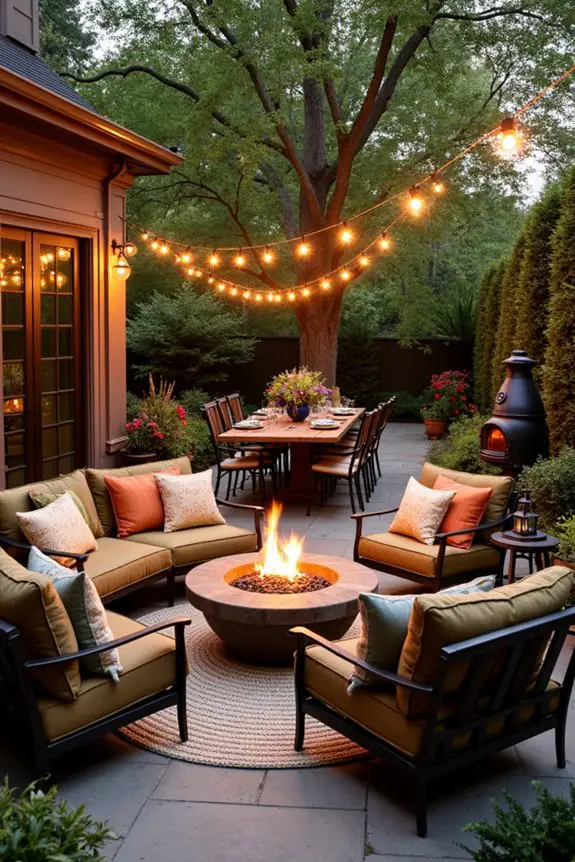
Creating outdoor living spaces is like bringing the cozy comfort of your living room outside but with a delightful twist of nature. It’s where you can sip your morning coffee while enjoying the chirping of birds or host a barbecue under a starlit sky. The beauty of outdoor spaces lies not only in their functionality—providing you with extra room for entertaining or relaxing—but also in the vibrant atmosphere they create. It’s all about setting the stage for memorable experiences, whether that’s a quiet reading nook or a lively weekend gathering.
First up, consider defining your space with comfortable seating. Think about a mix of lounge chairs, benches, and maybe even a swinging hammock. Picture yourself lounging with a good book, the sun warming your skin, and a gentle breeze rustling the leaves. When choosing your seating, go for weather-resistant materials like teak or powder-coated metal, because let’s be honest, no one wants to drag their chairs inside every time it rains.
A cozy arrangement encourages conversation; you might find that a circular setup invites more friendly banter than a straight line. Pro tip: add cushions for extra comfort—your lower back will thank you later.
Next, think about creating sections in your outdoor space. This can be as simple as placing a fire pit in one area surrounded by chairs, with a dining table nestled nearby for alfresco meals. By segmenting your yard, you divide up the activities, ensuring everyone feels like the space is designed for them.
Picture a little fire pit where friends roast marshmallows, while a dining area nearby becomes the go-to spot for swapping stories over grilled burgers. To add an extra touch, consider incorporating a weather-resistant rug under your seating; it can help define the areas and make everything feel a bit more homey.
Now, lighting is the magical touch that turns a decent outdoor area into something truly enchanting as the sun sets. String lights draped overhead create an inviting glow, while lanterns placed on tables provide a nice ambient flicker. Don’t underestimate the power of candlelight—just make sure they’re in safe holders unless you’re going for an accidental “how to put out a lantern fire” tutorial.
Think of lighting as the accessory to your outfit; it completes the look and elevates the vibe. If you really want to be fancy, consider solar-powered lights along pathways to guide guests without requiring much upkeep or running up the electric bill.
Finally, adding greenery is essential to tie everything together. Potted plants, hanging baskets, or even a small herb garden can liven up your space. Not only do these elements bring in pops of color, but they also make your outdoor area feel more connected to nature.
Planting herbs like basil or mint is a bonus—you can snack as you sip your drinks and enjoy the fresh scents. Just be mindful of the sizes; some plants can get a little too friendly with their neighbors and start encroaching on your space.
Get creative with your plant arrangements—use varying heights and textures to create visual interest. A feature like an outdoor chiminea fireplace can also enhance your outdoor space, offering both warmth and a stunning focal point.
5. Sustainable Material Choices
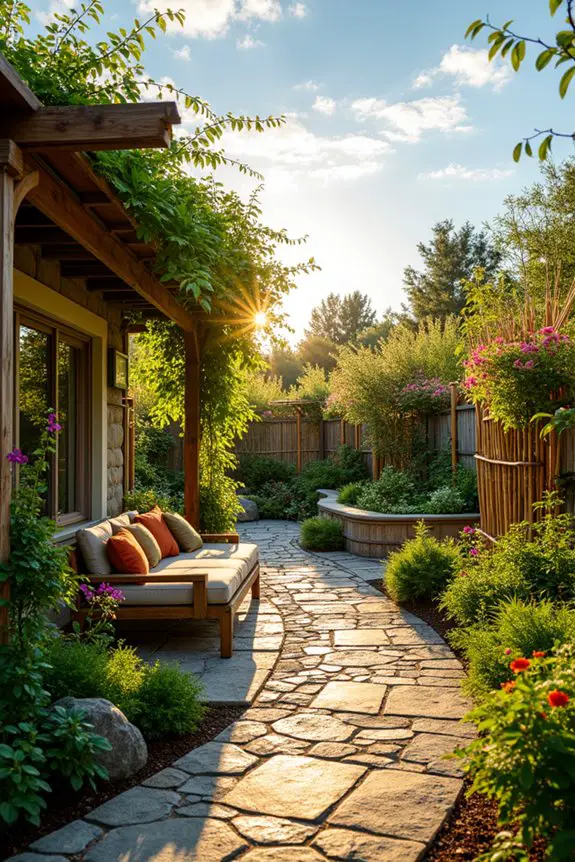
When it comes to garden design, using sustainable materials isn’t just about doing your part for the environment; it’s also about creating a beautiful, unique space that reflects your personality and values.
Imagine stepping into your yard and feeling the warm, rustic charm of eco-friendly wood, or strolling along a pathway made from recycled stones that tells a story of sustainability. The vibe? It’s a blend of natural elegance and conscious living that invites everyone to kick back and enjoy the beauty of what’s around them.
Start by considering reclaimed wood for your seating or raised garden beds. This has a double effect: it provides a gorgeous, weathered look that’s full of character and keeps lumber out of landfills. You can easily find reclaimed wood at local furniture shops or online marketplaces.
When building, be certain to sand it down to avoid splinters that would have you hopping around like you stepped on a Lego. Give your wood a good coat of eco-friendly sealer to protect it from the elements—after all, we want it to last longer than your last three plants that mysteriously died of neglect.
Next, think about using bamboo. Ah, bamboo! It’s not just for pandas. This fast-growing grass is super strong and works beautifully for everything from fencing to trellises. You can create a chic screen for privacy or even a stunning archway for climbing plants.
Pro tip: When selecting bamboo, look for ethically sourced varieties. Not only does it make a stylish statement, but it also supports sustainable farming practices, and that’s something you can feel good about every time you sip your iced tea in the shade it provides.
Another sustainable choice is permeable pavers or gravel for your pathways. These materials allow rainwater to soak through, reducing runoff and keeping your soil happy. It creates a naturally rustic vibe, which is perfect if you want your garden to feel like a serene escape.
When laying them down, make sure you start with a solid base. You can create a pattern that guides the eye—maybe a curvy path that mimics the flow of nature or a geometric design for a modern touch. Just remember, this is no race; take your time.
After all, transforming your outdoor space can be as therapeutic as pulling weeds—okay, maybe a bit less painful.
Don’t forget about your furniture! Opt for sustainable materials like FSC-certified wood, or better yet, look for second-hand pieces that you can paint or refurbish.
It’s not just good for the planet; it’s also a fun project. You know, the kind that starts with “I swear I can totally do this” and ends with you stuck in a cloud of paint fumes while pondering your life choices. But in the end, you’ll have a unique piece that brings charm and character to your space.
6. Functional Pathway Arrangement
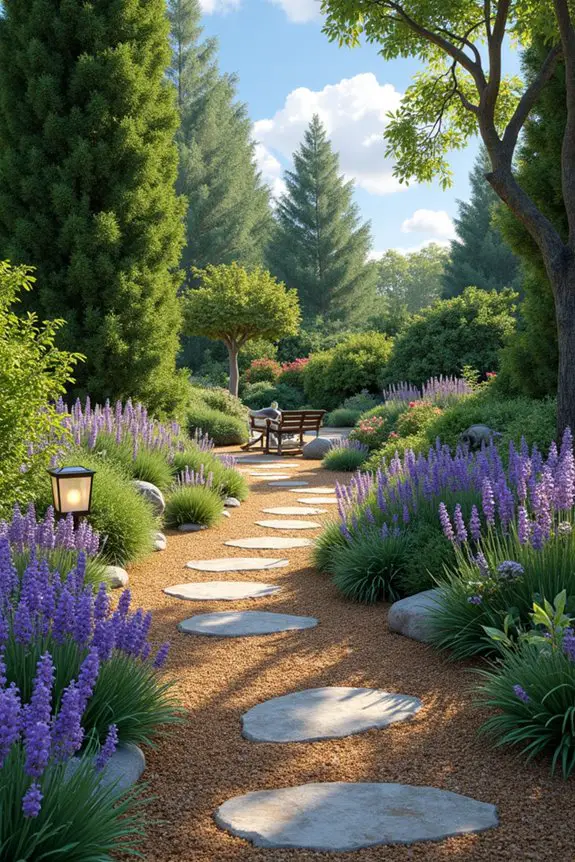
Creating a functional pathway arrangement in your garden isn’t just about providing a way to maneuver through your plants; it’s also a chance to express your style and creativity. Think about how a well-placed path beckons you along like a gentle invitation to explore, revealing your garden’s hidden gems at every turn.
It combines both practicality and charm, giving your garden a cohesive flow that feels welcoming and organized.
Let’s plunge into some ideas here. First, consider the shape of your pathway. Curved paths can create a sense of mystery, as they lead the eye around corners, revealing new garden nooks and crannies you might’ve forgotten about. You might start by marking your intended path with a simple garden hose or even some string—this gives you a visual idea of the flow without committing to anything just yet.
And hey, while you’re at it, think about the size. Wider paths can create a grand feel, while narrow paths guide you into a more intimate space.
Now, when it comes to materials, why not mix it up? Try combining gravel with larger stones or recycled bricks for added texture. This not only looks intriguing but allows water to drain, making your path functional and practical during those spring showers.
When laying down your base, aim for a depth of at least four to six inches of gravel. It’s like giving your pathway a nice, cushy bed to sleep in. Use a tamper to pat it down—trust me, your feet will thank you later when you’re not maneuvering your way through a rocky minefield.
Once your base is set, don’t skimp on the details. You might consider lining your pathway with small plants or herbs, which can serve as a fragrant guide and make your stroll even more enjoyable. Who doesn’t want a whiff of fresh lavender or mint as they saunter by?
It’s like adding a sprinkle of magic to your everyday stroll right in your own backyard.
And if you’re feeling extra whimsical, think about incorporating garden art or lighting along the edges of your paths. It can be simple fairy lights, or those solar-powered lanterns that pop up like mushrooms at night. They not only enhance the mood when dusk rolls in but also affirm you don’t trip over the garden gnome you forgot to move last summer.
Finally, always remember to step back and assess your pathway after you’ve laid it out. Walk through it and see how it feels. Does it draw you in? Is it easy to maneuver?
Taking the time for this last check can save you from the “what was I thinking” moments down the line. Garden paths aren’t just a functional element; they can reflect your personality and beckon guests to take a journey through your outdoor oasis. Happy designing!
7. Water Feature Integration
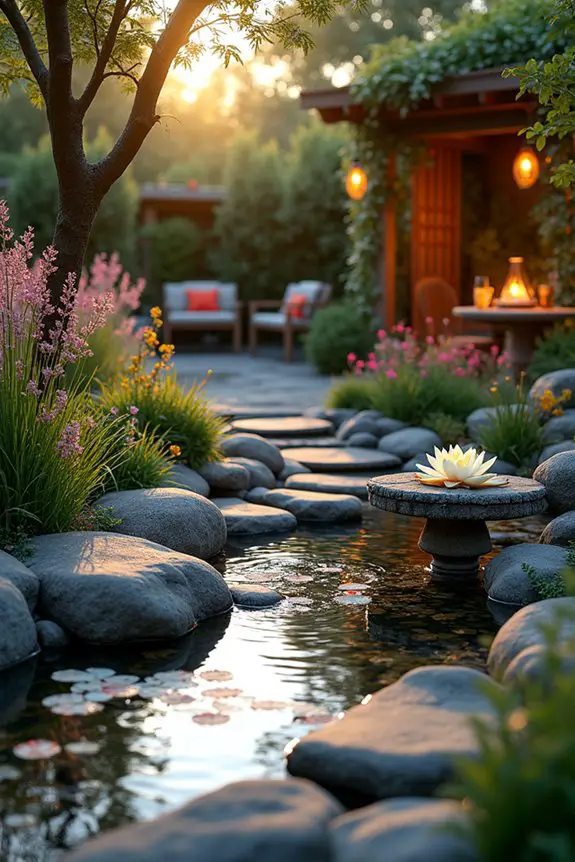
Alright, let’s chat about water features. Integrating a water element into your garden doesn’t just scream “fancy,” it whispers “tranquil oasis,” doesn’t it? It serves both a functional purpose—like attracting wildlife, you lucky gardener—and it sets a vibe that practically begs you to plop down with a good book or a glass of lemonade.
Plus, the gentle sounds of splashing water can drown out the chaos of the outside world, making your garden feel like a calm retreat.
So, how do you go about bringing this watery wonder to life? First, take a moment to visualize where it fits best within your garden’s existing layout. A small pond tucked into a corner can create a secret hideaway, while a fountain in the center can become an eye-catching focal point (and, let’s be honest, the ultimate Insta shot). If space is tight, even a simple birdbath can add that touch of serenity without hogging all your real estate.
Now, here’s a little trick: don’t just slap down your water feature haphazardly. Think about how it complements the rest of your garden design. Surround it with your favorite flowers or some lush greenery to help it blend in rather than sticking out like a sore thumb.
And if you really want to go the extra mile, consider adding some stepping stones around it. It’ll bring a playful touch and give you a reason to hop around the water feature, which can be particularly fun when you have a bunch of kids (or myself—yep, I occasionally indulge in a little hopscotch).
Next up, maintenance—you didn’t think you could escape this, did you? Regular cleaning is essential to keep the water clear and inviting. Trust me, nothing kills the zen vibe faster than a mucky, greenish pond.
This may mean skimming leaves, checking the pump, and adding beneficial bacteria to help with algae control. It’s not exactly a spa day for you, but just think of it as a bit of self-care for your garden’s water feature. And hey, while you’re at it, maybe treat yourself to a little snack—you’ve earned it.
Let’s not forget about the wildlife. If you’re hoping to attract some feathered friends or playful frogs, plant some native grasses or shrubs around your water feature. This creates a natural habitat for them, and they might just reward you with visits that bring your garden to life.
Picture it: birds flitting around, frogs croaking their little songs, and you, sitting there with a satisfied grin—nature’s own fan club.
Lastly, don’t shy away from lighting. Adding some soft, ambient lights can transform your water feature into something truly magical at night.
Whether it’s colorful LED lights submerged in the water or lanterns lining your pathway leading to the feature, they’ll cast a glow that makes your garden enchanting after sundown. Just don’t be like me and trip over the garden hose trying to get a closer look; we want to enjoy the beauty, not create chaos.
8. Wildlife-Friendly Features
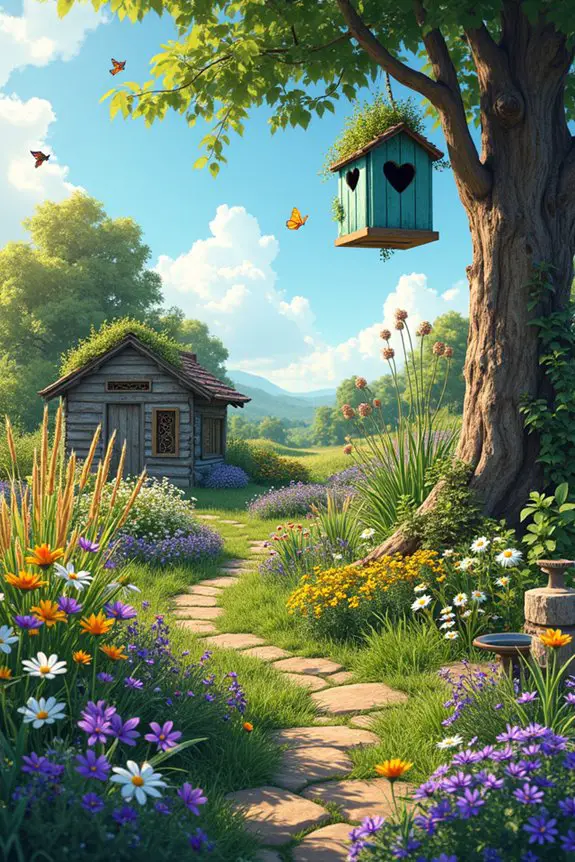
Creating wildlife-friendly features in your garden is like hosting a neighborhood block party for nature. Not only does it invite charming critters to join your outdoor space, but it also enriches your garden’s ecosystem, making it a fun and vibrant place to relax and unwind. Plus, there’s something incredibly satisfying about seeing a butterfly land on your petunias or a squirrel making a home in your hedges.
To get started, think about incorporating some native plants. These species are like the local cuisine for your wildlife—a buffet tailored to the animals who live nearby. They thrive in the local climate and soil, so less worry about keeping them alive. You could mix colorful wildflowers with grasses that sway gently in the breeze; this combination not only looks great, it also provides habitats and food sources for bees, butterflies, and other pollinators.
Picture yourself enjoying a sunny afternoon, sipping lemonade while watching a parade of butterflies flitting from flower to flower. That’s the life, right?
Next, add some shelter. This could mean building a simple brush pile using fallen branches or making a cozy home for smaller animals with a birdhouse. Consider creating a charming little nook with some stones or logs piled together—think of it as a woodland hideaway for your furry friends. When designing your garden, leave a few spots a little less manicured; nature has a way of thriving in the messiness. Trust me, embracing a little disarray can work wonders.
Water is another key ingredient—yes, we’re going back to water, but it’s so essential. You can integrate it with your ponds or birdbaths, ensuring there are clean, safe spots for furry and feathered visitors to drink or bathe. Add some flat stones around your water feature; they not only look pretty but also provide a landing pad for birds to hop down without slipping into the water.
You’ll have happy little visitors splashing about, and honestly, you might just find yourself chuckling at their antics.
Now, if you’re up for it, why not create a small insect hotel? It can be as simple as stacking wooden pallets filled with twigs, leaves, and pine cones in a corner of your garden. These little shelters will attract beneficial insects, like ladybugs and lacewings, which can help with pest control.
Think about it: your little DIY project becomes a bustling hotel for nature’s tiny workers. It’s practically a five-star resort for bugs, and they’ll be working hard to keep your garden in tip-top shape.
9. Seasonal Bloom Arrangements
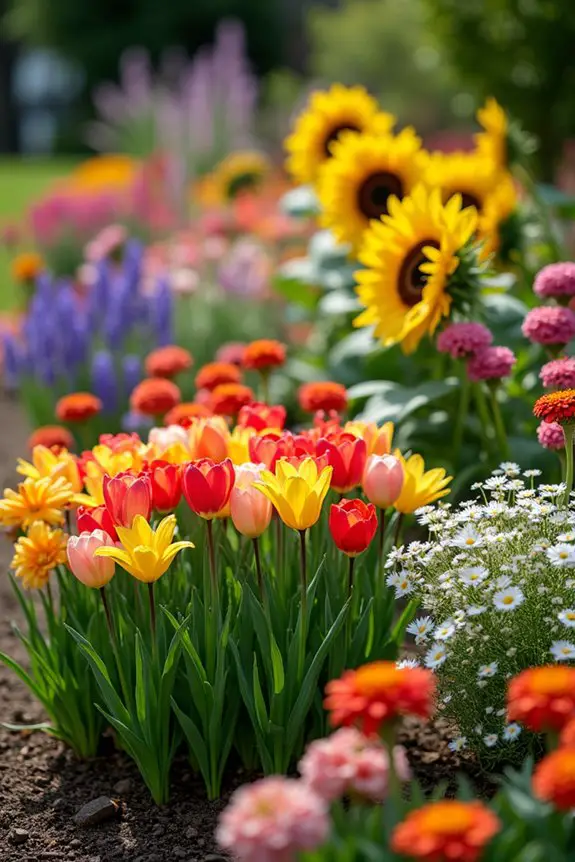
Imagine stepping into your garden and being greeted by a vivid tapestry of colors, textures, and scents that vary with each season. That’s the beauty of a well-planned seasonal bloom arrangement. Not only does it keep your garden looking fresh and inviting all year round, but it also creates a dynamic and lively atmosphere that reflects nature’s rhythms. Who wouldn’t want to stroll through a garden that looks like it’s celebrating each month with a new style?
To get started on your seasonal bloom arrangements, think about what flowers are in vogue throughout the seasons in your area. For spring, reach for cheerful daffodils, tulips, and hyacinths that pop with joy as the world shakes off winter’s chill. Come summer, introduce some sunflowers, daisies, and zinnias that echo the laughter of long, sunny days. And in fall, capture the rich hues of marigolds, asters, and chrysanthemums that sway gently in the autumn breeze.
Selecting a mix of early, mid, and late bloomers guarantees that your garden remains colorful from dawn until dusk, and you can easily plan your planting calendar so you’re never lacking in botanical brilliance.
When laying out your flower beds, consider grouping your seasonal flowers by color, height, or bloom time for an eye-catching effect. For instance, you might create a rainbow effect with bright yellows in the front, shifting to softer peach and lavender toward the back as the beds rise. This way, it’s like you’re painting with nature, inviting guests to take pictures and soak in all that beauty.
But don’t forget to play with textures, too. Mix in some delightful foliage plants or ornamental grasses; they add depth and movement, sort of like that perfect soundtrack that elevates a movie scene.
Now, here’s a little pro tip: stagger your planting timelines. For the spring blooms, plant bulbs in the fall so they can surprise you with their early arrivals. For summer flowers, start seeds indoors or buy seedlings as the last frost passes; you don’t want your tomatoes and pansies fighting over space too early.
Mark your calendar (or set a reminder on your phone) for when to plant and deadhead—yes, deadheading is just fancy talk for snipping off the spent blooms to encourage new growth. Trust me; your flowers will reward you with more blooms, and you’ll feel like the proudest gardener in the neighborhood—while everyone else is looking at their withering daffodils.
And don’t forget to enjoy the process. Gardening doesn’t have to be a chore. If your flower arrangement looks a bit like a toddler spilled paint all over it—embrace that chaos. It shows you’re working with the soil and the seasons.
After all, nature tends to be a bit wild at heart, and you’re just a guest at its gorgeous party. Plus, each season will genuinely give you fresh reasons to fall in love with your little patch of paradise all over again. So, roll up those sleeves and dig in—your vibrant seasonal display waits just beneath the surface.
10. Themed Garden Aesthetics
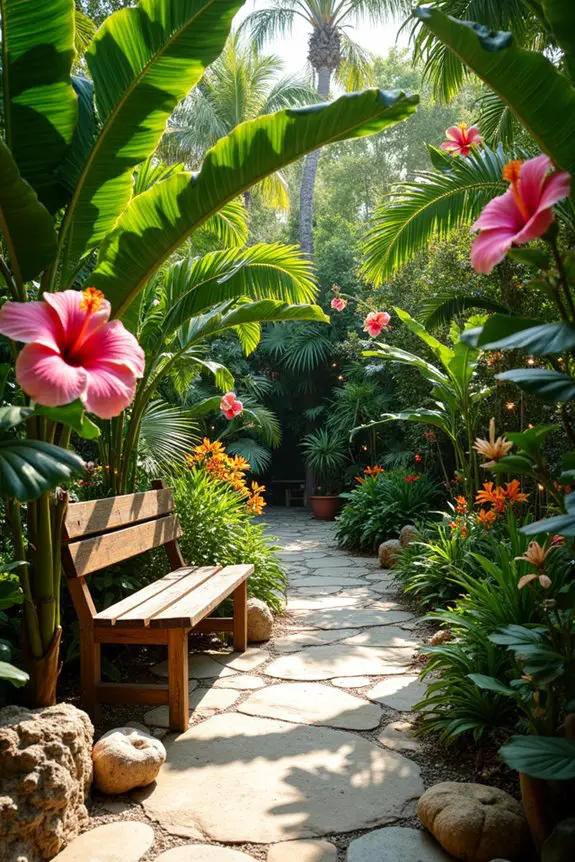
When it comes to garden design, themed aesthetics can transform an ordinary plot into an extraordinary escape. Not only do they provide a sense of harmony and purpose, but they also allow you to express your unique style and personality. Imagine wandering through a garden that tells a story—a whimsical fairy tale, a serene zen retreat, or even a rustic French countryside vignette. Each design not only looks great but also enhances the functionality by organizing plants and elements in a purposeful way.
Let’s explore the creation of a themed garden, shall we? Start by choosing a theme that speaks to you. Maybe you love the beach—who doesn’t dream of the sound of crashing waves and soft sand? Picture tropical plants like hibiscus and plumeria, combined with decorative shells and driftwood. Or perhaps you’re drawn to an English cottage garden, filled with fragrant roses, cheerful daisies, and charming stone paths that beckon you to wander. The first step is all about envisioning what makes your heart flutter.
Once you have a theme, it’s time to gather your materials, both plants and décor. This is where the real fun begins! Make a list of plants that fit your theme. If you’re going tropical, think palms and ferns. For a cottage vibe, opt for a mix of perennial flowers and climbing vines. Remember, variety is the spice of life, so playing with different heights, colors, and textures is key.
Also, don’t forget to check your local climate and soil conditions—yes, even the best of us need to do a little homework before we embark.
Next up, layout. Visualize your space and sketch a simple design on paper. You can keep it super basic—just circles and squares to represent beds and paths. Position taller plants at the back (or middle if it’s an island bed), letting shorter plants have the spotlight in front.
And here’s a quick pro tip: consider adding hardscaping elements like stones, trellises, or benches that match your theme. These features can really anchor your garden and make it feel more cohesive. A bench in a zen garden, for instance, offers both style and a peaceful place to sit and reflect.
Now let’s talk maintenance because, let’s be honest, nobody wants a garden that looks like it’s been through a tornado—especially if it’s themed. Try to choose plants with similar care requirements. If half of your garden loves full sun and the other half thrives in shade, you might end up with a chaotic mess.
And deadheading is your best friend here; do it regularly, and your themed garden will keep looking its best. A little grooming goes a long way—just like that half-empty bottle of fancy shampoo, right? Never let it sit.
As you bring your themed garden to life, make sure to enjoy the process. Nothing beats the feeling of watching your plan come together, like the best recipe finally coming out just right.
And if you mess up a little—like maybe you accidentally plant sunflowers instead of lilies—smile and embrace the chaos. It’s those unexpected surprises that can make your garden truly unique. Plus, it gives you a great story to share at the next neighborhood barbecue.
Budget-Friendly Gardening Techniques
While it might feel challenging to make a beautiful garden on a budget, you can actually thrive with just a little creativity and a pinch of resourcefulness.
First off, check local nurseries for discounted plants or swap cuttings with friends; those freebie plant exchanges are goldmines for fun garden design ideas.
Ever thought about using repurposed materials? Old pallets can be transformed into trendy planters or garden furniture.
Got a stash of seeds lying around? Plant them—nothing beats homegrown veggies, and they won’t break the bank.
Mulching with grass clippings or leaves isn’t just smart; it keeps costs down too.


